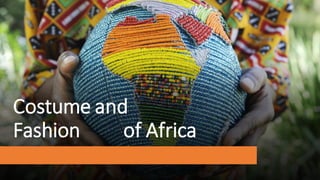
Costume and Fashion of Africa
- 1. Costume and Fashion of Africa
- 2. Introduction • African clothing is known for its colorful fabrics and distinctive designs. But few people take the time to examine the cultural significance of African fashion. The presence of textiles in the African world dates back to Phoenician times. At various times in history, migration, and integration have spread African textiles to different regions of Africa and the world. The colorful clothes of Africa first became a sign of wealth around 1000 BC during the period of the trans- Saharan trade when traders used strip cloth as a form of currency. As a result, African textiles became known worldwide. During the European coastal trade in the 1400‘s, African fabrics where preferred by traders over fine European fabrics. Traders used African cloth in the triangular trade of the 17th and 19th centuries. African traders exchanged cloth from India for
- 3. The precise origins of cloth production in Africa are lost in time, but archaeological findings indicate some of the earliest sites. Drawings of looms can be seen in the tombs of ancient Egypt, dating back to at least 2000 B.C.E. Archaeologists have found linen remnants in ancient Egypt, as well as fifth-century cotton cloth remnants in Meroe, in northern Sudan. In West Africa, woven fiber pieces dating back to the ninth century C.E. have been found in Nigeria, and woven cotton cloth dating to the eleventh century has been recovered in Mali. Evidence of loom use in Mauritania dates back to the eleventh century. Clothing in Africa The two main kind of textile looms in Africa are the double-heddle loom, used for narrow strips of cloth, and the single-heddle loom, used for wider pieces. The narrow strips are typically sewn together, then cut into patterns for clothing. The double-heddle loom is generally used only by male weavers, who use it to weave in colored threads and create richly textured fabrics. In addition, weavers in North Africa and in Ethiopia also use ground looms, while looms similar to those used in Southeast Asia are found in Madagascar. Although Africa's weavers produce a wide variety of patterned, colored fabric, they also weave plain cloth. This cloth can either be used "as is" for daily wear around the home, or it can be decorated. Common fabric-decorating techniques include appliqué designs, sewn on in contrasting fabrics; embroidery with brightly
- 4. In order of traditionand value, 1) weaves, 2) tie dyes, 3) batiks, and 4) industrialprints represent the four types of cloth Africans use to create clothing. Woven cloth, the oldest and most valuabletype of fabric, is the most time consuming to make. Weaving represents a traditionthat passes down from father to son and from uncle to nephew, and from mother to daughterand aunt to niece. The complexity of the weave, the color, and the type of thread used, determines the value of the fabric. The use of locallyspun threads enhances the value of the cloth, as Africans believe that imported textiles have no ancestral link and therefore less value. Today,despite this belief, Africans sometimes use Europeanmanufacturedthread to weave cloth. Types of Clothing Bogolanfini,aso oke, kuba raffia, kente, and country cloth offer examples of woven cloth. Bogolanfini,also known as mud cloth, is the traditional clothfrom the countryside north of the Maliancapital,Bamako. With rich blacks, browns, and whites, sections of cloths are composed of individualmotifs or a combinationof motifs such as ―fish bones‖, ―little stars‖, or ―square‖.
- 7. Asoke, a traditional cloth of the Yoruba, has three main designs: etu, a dark blue indigo dyed cloth (a verse from an Ifa divination text describes it as the ―father of all cloths‖); sanyan, a brown cloth woven from the beige silk of the Anaphe moth; and alaari, woven from Southern European silk obtained from the Sahara via Tripoli. Kuba raffia, the traditional cloth of the Kuba people of the Democratic Republic of Congo, remains an example of a tradition of raffia weaving that was once widespread throughout central Africa. Kente, probably the best known of these, was worn by the political authorities and high- ranking officials of the Ashanti people presently found in Ghana. A colorful fabric of golds, yellows, reds, blacks, greens, and blues, each intricately designed piece of fabric is a functional object that conveys messages about historical
- 8. Native clothing • Kaftans • Kaftans,which are also called boubous, are full-length embroidered robes. This garment, which • today is mainly worn by East African women, was originally only worn by West African men. • Made from cotton or silk, kaftans button down the front.It's also the traditional female clothing • of many countries in West Africa such as Mali, Senegal and Ghana.
- 9. African Women'sClothing Traditional African women's clothing comes in various styles, prints and colors ranging fromearthtones to vibrantindigos. Women's clothing may include beaded skirts, blankets and veils with elaborate motifs. African women are known for their colorfuljewelry, which is made fromcopper, beads and grasses. Ndebele women, living in South Africa's Gauteng Province, arenoted for wearing colorfultraditional clothing adorned with beadwork. Becausetemperatures can soar as high as 125 degrees in the Sahara Desert, it's common to see women there going topless.
- 10. THANK YOU Present by: Sunita Suthar M.sc - 1year